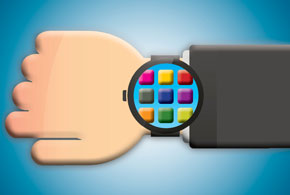The adoption of wearables in corporate enterprises and industrial settings should increase significantly by 2020, meaning that Internet-connected eye wear, smartwatches and even gesture-controlled devices should become a more visible part of everyday business.
In fact, wearables that are shipped for use in the workplace in 2020 will represent 17 percent of the total devices sent out—a big jump from the 1 percent shipped in 2013, according to “Wearable Devices for Enterprise and Industrial Markets,” a report from Tractica, an independent market research firm. The availability of different wearables, as well as the growing need for efficiency in enterprises and industry, will drive this trend.
“The growth in shipments will come from smartwatches being used in the workplace, as a part of the bring-your-own-wearable [BYOW] trend,” wrote Tractica Research Director Aditya Kaul by email. “Part of it will also be driven by corporate wellness programs, where smart watches will be preferred over fitness trackers.”
Kaul also sees smart glasses becoming the heart-and-soul of wearable adoption in the workplace. Although they aren’t expected to drive shipments or to be candidates for BYOW, they will bring a unique advantage and improved efficiencies in the workplace, he says.
Smart glasses will be particularly useful in field services, manufacturing shop floors, mobile workforce applications and warehouses. They will also find likely use in enterprise environments for tasks such as 3D/CAD modeling or, in the future, to complement or replace desktop computing.
Tractica’s report shows that enterprise and industrial shipments of wearable units should reach 27.5 million by 2020, up from 166,000 in 2013, a compound annual growth rate of 108 percent. Also, the company forecasts that revenue from these shipped units will rise from $14 million in 2013 to $6.3 billion by 2020, a CAGR of 140 percent.
“The enterprise trend is just starting out, currently with smart glasses leading the fray,” Kaul says. “However, we see smartwatches taking over with BYOW in the enterprise, which will cause the real uptick in growth.”
A number of Fortune 500 IT departments are even expecting a large number of Apple watches to come onto their networks, particularly among senior management teams, he says. Kaul sees this moving toward a trend in which smartwatches become commonplace over time as more enterprise-specific applications come on board and prices drop.
“Along with that, a number of other wearable devices—like smart glasses, fitness trackers, smart clothing and wearables cameras—will also see increasing adoption,” he adds.
Staking a Claim in the Wearables Market
Tractica’s report may bode well for companies like Apple, Fitbit and Vuzix, all of which have staked a claim in wearables. Vuzix, for example, already produces smart glasses for use in entertainment, enterprise and research environments.
“Vuzix is helping companies in warehousing to enable more efficiency with scanning barcodes and picking packages,” says President and CEO Paul Travers. “A hands-free wearable barcode scanner is creating an ROI that’s hard to ignore.
“If a company can gain an edge on their competition by utilizing smart glasses, it will reap the benefits of performing tasks more efficiently, often while giving employees a better on-the-job experience with a product that is easy to use.”
Gesture-controlled devices are also likely to gain a presence in the wearables market, according to Tractica. Although development is still in its early stages, as these devices become more fine-tuned in their ability to track movement, this functionality could eventually become embedded in smartwatches or other arm-based wearables, according to Kaul.
Gesture control should initially take off in environments where there’s a need for hands-free interaction with machines, such as computers, general machinery and robots.
“As we start to use virtual reality/augmented reality [VR/AR] glasses, gesture control or haptic [technology that recreates the sense of touch] control is more likely to get adopted into the mainstream,” Kaul predicts.









